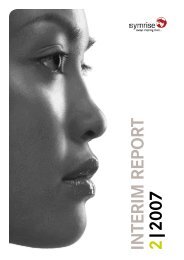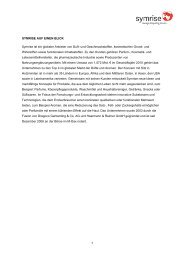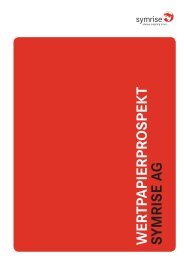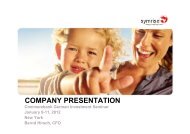THE NATURE OF OUR BUSINESS – STABLE GROWTH - Symrise
THE NATURE OF OUR BUSINESS – STABLE GROWTH - Symrise
THE NATURE OF OUR BUSINESS – STABLE GROWTH - Symrise
You also want an ePaper? Increase the reach of your titles
YUMPU automatically turns print PDFs into web optimized ePapers that Google loves.
Share Capital<br />
Ordinary shares<br />
Ordinary shares are classified as equity. Ancillary costs that directly<br />
result from the issue of ordinary shares or share options are<br />
recognized as a deduction from equity, net of any tax effects.<br />
Sale of Merchandise and Products<br />
Revenue from the sale of merchandise and products is shown at<br />
the fair value of consideration received or receivable less any returns,<br />
trade discounts and rebates. Sales revenue is recognized<br />
when the significant risks and rewards deriving from ownership of<br />
the merchandise or products have been transferred to the buyer,<br />
recovery of the consideration is probable, the associated costs<br />
and possible return of the goods can be reliably estimated and the<br />
amount of revenue can be measured reliably. The transfer of risks<br />
and rewards to the buyer is determined in accordance with<br />
INCOTERMS (International Commercial Terms).<br />
Leases<br />
Leases, under the terms of which the lessor retains all significant<br />
risks and benefits deriving from ownership of the leased object<br />
are to be classified as operating leases. Operating lease payments<br />
are recognized as an expense on a straight-line basis over the term<br />
of the lease. There are no significant finance leases.<br />
Financial Income and Expenses<br />
Financial income comprises interest income on funds invested, dividend<br />
income and changes in the fair value of financial instruments<br />
(interest swaps). Interest income is recognized in the income statement<br />
as it accrues using the effective interest rate method.<br />
Financial expenses comprise interest expense on borrowings, unwinding<br />
of discount on liabilities, changes in the fair value of financial<br />
assets and impairment losses on financial assets. All<br />
borrowing costs are recognized in the income statement using the<br />
effective interest rate method.<br />
Foreign exchange gains and losses are disclosed on a net basis.<br />
Income Taxes<br />
Income taxes comprise both current and deferred taxes. Income<br />
taxes are recognized in the income statement unless they are directly<br />
related to items that are directly recognized in equity.<br />
Current taxes are taxes that are expected to be payable on taxable<br />
profits of the current fiscal year. They are recognized using the<br />
tax rate applicable to the year reported. Additionally, any adjustments<br />
to tax expenses for previous years are also included here.<br />
Deferred taxes are recognized as at the balance sheet date by applying<br />
the liability method to all temporary differences between<br />
the carrying amounts of assets, or respectively liabilities, in the<br />
IFRS-based consolidated financial statements and the amounts<br />
used for taxation purposes. No deferred taxes were recognized<br />
with respect to the following temporary differences:<br />
› The initial recognition of goodwill<br />
› The initial recognition of an asset or a liability relating to a transaction<br />
that does not constitute a business combination and<br />
which affects neither the profit for commercial accounting purposes<br />
nor the taxable result.<br />
Deferred taxes are determined using the tax rates that are expected<br />
to be applicable to the temporary differences when these<br />
reverse and are based on tax legislation that has been enacted or<br />
announced before the balance sheet reporting date as being applicable<br />
at the time of the reversal. Deferred tax assets and liabilities<br />
are offset if there is a legally enforceable right to offset current<br />
taxes and liabilities and they relate to income taxes levied by the<br />
same tax authority on a company, or in the case of joint assessment,<br />
to different companies that have the intention to settle current<br />
assets or current liabilities on a net basis or to realize tax<br />
assets and tax liabilities simultaneously.<br />
Deferred tax assets are recognized to the extent that it is probable<br />
that taxable profits will be available in future against which deductible<br />
temporary timing differences can be offset. The carrying<br />
amount of the deferred tax assets is reviewed at each balance<br />
sheet reporting date and is reduced to the extent that it is no<br />
longer probable that sufficient taxable profits will be available to<br />
offset the deferred tax asset.<br />
Sales Tax<br />
Sales revenues, expenses, assets and liabilities are recognized net<br />
of sales tax.<br />
The following exceptions apply:<br />
› if the sales tax incurred on the purchase of goods and services<br />
cannot be recovered from the tax authorities, then the sales tax<br />
is accordingly considered to be a component of the expense<br />
item; and<br />
› receivables and payables are recognized with the amount of the<br />
sales tax included.<br />
106 Annual Report 2008 <strong>Symrise</strong> AG















